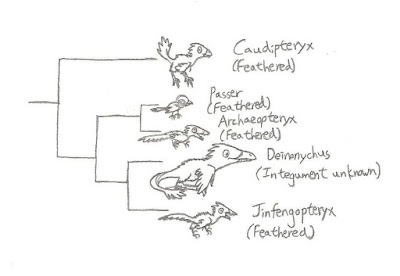The same way we know (as in, be quite certain) that extinct mammals without integument preserved very likely had fur: through phylogenetic inference.
We know that closely related organisms tend to be more similar to each other than to more distantly related ones because they share more characteristics with one another. With this in mind, we can often infer whether or not a characteristic is present in a fossil organism if we have enough data on its close relatives, even if we don't have direct evidence of that organism possessing or lacking said characteristic.
For example, we don't have the hands of Tsaagan, so, strictly speaking, we can't directly tell how many fingers it had. However, we do have the hands of its close relatives, and when we reconstruct the relationships between it and its relatives, we can see that both its closest known relative (Linheraptor) and its close-but-not-as-close relatives (such as Velociraptor) are both known to have had three-fingered hands. Therefore, we can infer that Tsaagan likely also had three-fingered hands.
We can do the same thing when trying to figure out what kind of integument maniraptors (or mammals, or lizards, etc.) that haven't preserved any direct evidence of their skin coverings had.
We don't yet have any unequivocal direct evidence of what kind of integument Deinonychus had, for example. However, its phylogenetic position shows that it's nested deep within a clade of known feathered dinosaurs. Some of these feathered dinosaurs are fairly close relatives of Deinonychus (such as Velociraptor or Microraptor). Perhaps more importantly, none of the members of this clade are known to have had any integument other than extensive feathering. (Most do have scales, but only on limited areas of the body such as the feet.) Therefore, it is reasonable to infer that Deinonychus also had feathers.
 |
| Simplified cladogram of Maniraptora using the Raptormaniacs cast. |
If this conclusion somehow sounds "shaky", it shouldn't be. At least, it shouldn't be any more shaky than the conclusion that Dinofelis likely had fur because it's nested deep within a clade of furry animals, or that Hesperornis had feathers because it's also nested deep within a clade of feathered animals. No one ever questions those because... I honestly don't know. In fact, such inference has already accurately predicted the presence of feathers in at least one case, Velociraptor. Even before quill knobs were discovered on Velociraptor in 2007, phylogenetic inference showed that Velociraptor likely had feathers.
Some "critics" of phylogenetic inference like to use the example of a modern elephant and a mammoth to show how "unreliable" this method is. If modern elephants were extinct and we only knew about the integument of mammoths, so the claim goes, phylogenetic inference would turn out to be completely wrong because it would lead us to think that modern elephants had fur. But, actually, that prediction would turn out to be entirely right!
 |
| Close up of an Asian elephant's eye showing integument (including specialized hair) photographed by Alexander Klink, from Wikipedia. |
That said, we wouldn't necessarily be able to predict accurately that modern elephants would have had such a sparse covering of hair. But we know from the anatomy of modern animals that even though the arrangement of integument can vary greatly based on environmental factors as well as sexual selection, the presence of integument is not nearly as variable. So we may not be able to tell exactly what the feathers of Deinonychus were like, but we can quite safely say that it did indeed have feathers, as well as infer some more general patterns.
Of course, phylogenetics doesn't always work. For example, the velociraptorine dromaeosaurid Balaur had two fingers instead of three. Had the hands of Balaur not been discovered, we might have thought it had three fingers. However, such examples would clearly be in the minority. For one two-fingered dromaeosaurid taxon there are dozens of three-fingered dromaeosaurid (and other avetheropod) taxa which would have had their finger count predicted accurately by the same method.
Is it technically possible that a maniraptor taxon had scales or fur or pycnofibers or tentacles or cornflakes covering most of their skin instead of feathers? I'll have to confess that, yes, it's technically possible, against all odds. But science doesn't care about what is technically possible. Is there evidence for these possibilities? No. So, until evidence in their favor is found, we can stop kidding ourselves that those possibilities are more likely than (or as likely as) an alternative for which we do have evidence: all maniraptors likely had feathers.
Is that too bold? Really? Any more bold than saying that all extinct mammals likely had fur or that all avian maniraptors likely had feathers?










your right I mean just because we haven't found a allosaur with eyes does not mean they were eyeless.
ReplyDeleteIt's interesting to note that Balaur has, in any case, been shunted along several basal positions within Avialae. Its resemblance to a dromaeosaurid is most likely due to convergent evolution. Whether or not we still need to be cautious about phylogenetic bracketing, that particular counterexample is no longer a counterexample.
ReplyDeleteThe details of that counterexample don't hold anymore. But most other avialans still have three fingers, so the principle remains.
Delete